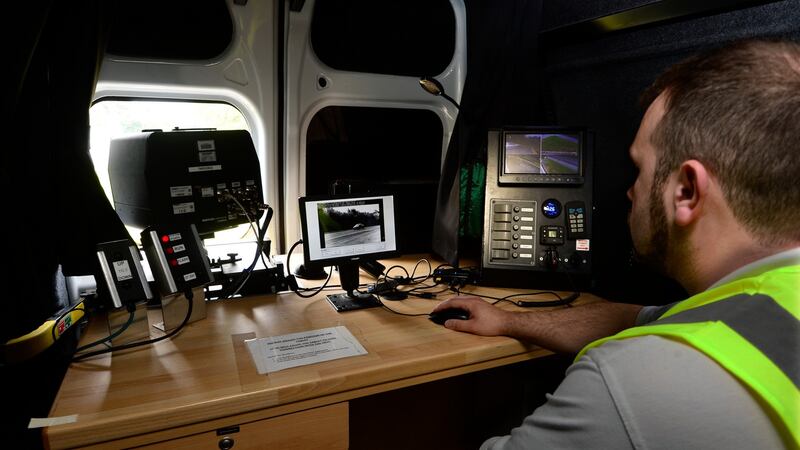Just before 10 on Friday morning, National Slow Down Day, Eric parked his GoSafe speed detection camera van on a slipway junction on the north-bound carriageway of the Stillorgan Road in Dublin and set about his work.
The inside of the high visibility Ford Transit van is like an old-fashioned photographer’s dark room – the walls and ceiling are covered in jet black cloth and black curtains block out the windows. But there is a desk where Eric sits, facing backwards, and controls the equipment.
This includes four external closed circuit, situation awareness cameras that keep an eye on the outside of the van itself. Inside, Eric sees what the CCTV cameras are monitoring and can resort to a panic button and klaxon alarm should the van receive any unwelcome attention.


Eric and his colleagues working for GoSafe, the private company whose 80 staff are contracted to the Garda to detect speed violations using 50 detector vans, which are always manned, at more than 1,000 locations across the country, do not disclose their surnames, just in case.
“I’ve never had any trouble,” says Eric. “You get the odd bit of abuse but nothing serious.”
Eric’s main task, at the outset of his three-hour stint at any location, is to boot up the speed detector camera, a square Redflex radar camera, that peers out the van’s rear window. He switches it on and sets it to photograph only vehicles that are travelling above the limit at the particular location, which at The Hill/N11 Stillorgan Road junction is 60 km/h.
Eric has been trained to do all this and examined for his proficiency.
Sophisticated
Once set up, Eric is not involved in any way in deciding which vehicles are photographed and which are not. That is done automatically by the camera, which is a sophisticated piece of kit.
Using two inbuilt radars, it can monitor up to eight lanes on a road, detecting vehicles travelling in either direction, and, where more than one vehicle is captured within the frame of a photograph, it can differentiate which one is breaking the speed limit.
At 10.08am on Friday Eric began monitoring. By noon, some 1,400 vehicles had passed the watchful eye of the radar camera and just nine were detected breaking the 60 km/h limit.
What is the worst he has seen?
“I was on the N7 one night near Goffs and I caught a car doing 204 km/h in a 100 km/h zone. That was at half two, three in the morning,” he says.
Despite empirical evidence that the cameras save lives (in zones where they are deployed, the number of fatal crashes has fallen from 31 per cent of all fatal crashes to just 14 per cent), the use of the cameras continues to attracts criticisms not supported by facts.
Cameras cover just 3.7 per cent of the national road network and are deployed only on stretches of road, up to 10 kms in length, that have a record of serious collisions.
Between Oatlands College and White’s Cross on the N11, for instance, in a five-year period since 2010, four people have been killed, two have sustained serious injuries and 36 have received relatively minor injuries in crashes.
Another myth is that drivers caught just slightly over the speed limit are always prosecuted. In reality, 80 per cent of prosecutions are for speeds that are 10-29 km/h over the limit. A further 10 per cent are for breaches that are 30-50 km/h over the limit.
"That should dispel the shooting fish in the barrel accusation," says Garda Derek Cloughley of the National Traffic Bureau.
The most persistent myth is that speed detection is a revenue raising exercise. However, the contractual cost of the system is not covered by the amount of money raised in fines, as academic study has shown.
“Every fatality costs between €2.3 million and €2.4 million in total terms,” says Cloughley, “that’s the cost of the emergency services, of the hospital and medical services, the cost of the investigation and that loss of the person’s potential earnings in their life. That’s the monetary cost.”
At the end of his 11-hour shift on Friday, where he monitored speeds at three separate locations in Dublin, Eric’s colleagues at GoSafe HQ in Listowel passed the evidence gathered by his camera to the Garda.
Fines and penalty points are on the way.
The Garda say that 133,556 vehicles were monitored during Slow Down Day up to 10pm.










